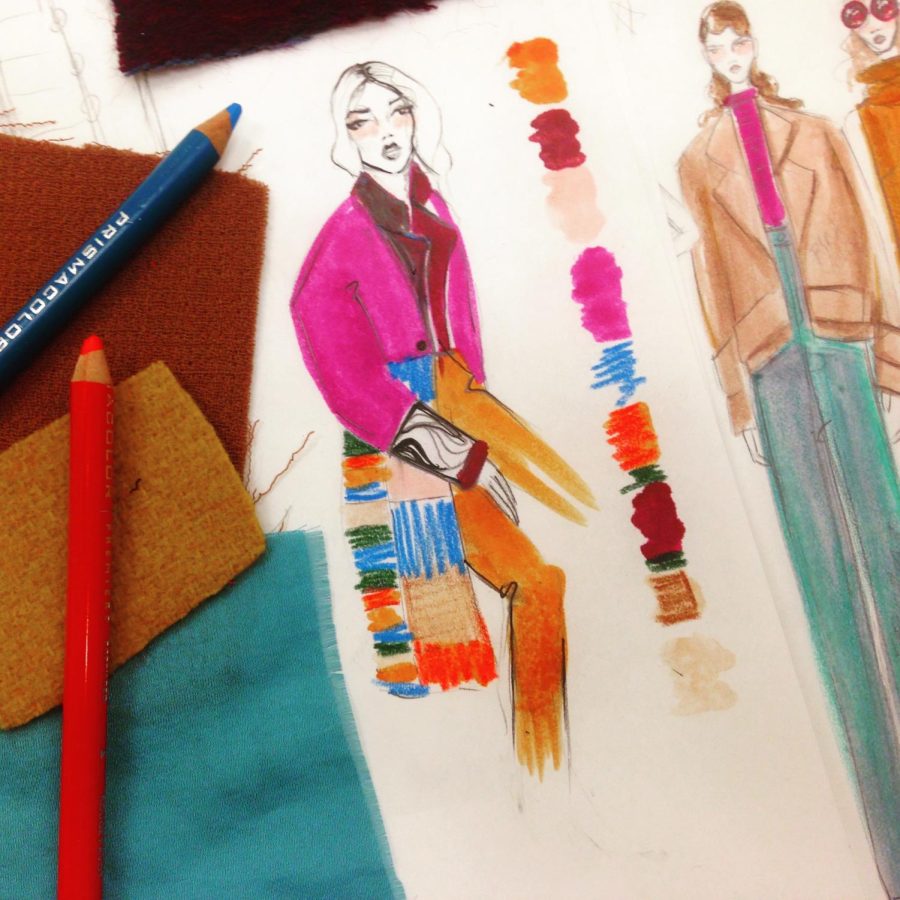Students continue to learn value of sketch
February 15, 2017
Long before the glossy fronts of magazines were adorned with celebrities and models, fashion illustrations in periodicals and costume books arrested the attention of those admiring their artistry.
The sketches, created by designers or interpreters of sample clothing lines, were used to market the new collections. Their popularity in the 1800s is something celebrated as a long-lost artform in museums in New York City, Paris and Milan.
Making way for fashion photography, the designs of the past were left to be considered a renaissance – the process much too slow and lacking detail the masses demanded on the covers of Harper’s Bazaar and Vogue.
Today, the art of illustration is much less popular in mass media, but is a dominant means of interpretation for fashion design students at Kent State.
For Alia Bertot, a junior fashion design major, sketching her illustrations allows her designs to evolve seamlessly, unless, of course, unwieldy stitching is what she’s going for.
“Sketching out my fashion designs is so crucial to my design process,” Bertot said. “Sketching out figures helps bring your design to life and helps to give you a clear visual on what you want to do when you eventually create your garment.”
Junior fashion design major Dani Bennett agrees, adding in that she’d never leave her house without her sketchbook.
Design students are encouraged, and often graded, on their initial sketches. It also allows for them to conceptualize an outfit they may be able to create at some point in their careers; problem solving with a pen and paper.
However, senior fashion design major Meleah Honeycutt knows there are only so many resources made available to students. Often times she’s left seeking materials her designs need, but aren’t accessible.
“The biggest challenge in sketching is designing a garment before you have the fabric,” Honeycutt said. “Sometimes I’ll fall in love with a design and be very disappointed when I can’t actually find the fabric I visualized in my head.”
The 300-year-old artform of fashion illustration isn’t easy to manipulate to suit the tech-driven audience of today, but Bertot sees illustrations on social media every day as she chooses to follow artists that curate the art. And for Bennett, the initial drive to begin studying fashion came from popular musicians like Lou Reed, Bootsy Collins and David Bowie.
Between the three, watching the illustrations come to life in any form is what is truly awe-inspiring.
“It’s very surreal to see a garment from my own head on a runway or on a person. At that point, the garment has changed so much in the process, it’s almost like it’s a completely different design, but in a good way … in a great way,” Honeycutt said. “Kind of like finishing a novel and realizing it’s better or worse than what you originally planned.”
Bennett said the illustration process is one that’s constantly evolving, even in the final stages.
“Sometimes, the design looks exactly how you envisioned it in the drawings, and other times, the design evolves as you sew it and try it on a mannequin countless times,” Bennett said.
The three hope their designs will lead to a field they’re passionate about. Bertot said sketching her designs has taught her that there’s always room for improvement. But what they all agree on is how the fluidity of fashion illustration has changed their perspective on “wrongness.”
“Sometimes the accidents, squiggly lines and unerasable pencil marks end up being unexpectedly my favorite designs,” Honeycutt said.
Payton Moore is a features correspondent, contact her at [email protected].












